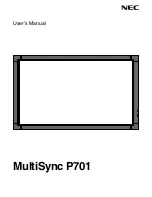
English-6
Attaching Mounting Accessories
The display is designed for use with the VESA mounting
system.
1. Attach Mounting Accessories
CAUTION:
Attaching mounting accessories must be done
by using eyebolts (M12).
Do not attempt to mount or carry the display
using your own strength as the display may fall
and cause personal injury.
When attaching the mounting accessories, do
not cover the fan.
Be careful to avoid tipping monitor when attaching
accessories.
Mounting accessories can be attached with the monitor in
the face down position. To avoid damaging the screen face,
place the protective sheet on the table underneath the LCD.
The protective sheet was wrapped around the LCD in the
original packaging. Make sure there is nothing on the table
that can damage the monitor.
When using mounting accessories other than those that are
NEC-compliant and approved, they must comply with the
VESA-compatible mounting specifications.
2. Using optional tabletop stand
CAUTION:
Installing and removing the stand must be done
by using eyebolts (M12).
Do not attempt to mount or carry the display
using your own strength as the display may fall
and cause personal injury.
a. Installing and removing optional tabletop stand
To install, follow those instructions included with the optional
stand or mounting apparatus. Use only those devices
recommended by the manufacturer.
To attach the optional stand to the monitor, lift the monitor
using a lifting device with eyebolts (M12), then insert the
stand into place.
VESA Mounting Interface
400 mm
400 mm
Orientation
•
When using the display in the portrait position, the
monitor should be rotated clockwise so that the left side
is moved to the top and the LED indicator light is on the
bottom. This will allow for proper ventilation and will
extend the lifetime of the monitor. Improper ventilation
may shorten the lifetime of the monitor.
LED Indicator
Mounting location
•
The ceiling and wall must be strong enough to support
the monitor and mounting accessories.
•
DO NOT install in locations where a door or gate can hit
the unit.
•
DO NOT install in areas where the unit will be subjected
to strong vibrations and dust.
•
DO NOT install near where the main power supply
enters the building.
•
Do not install in where people can easily grab and hang
onto the unit or the mounting apparatus.
•
When mounting in a recessed area, as in a wall, leave at
least 4 inches (10cm) of space between the monitor and
the wall for proper ventilation.
•
Allow adequate ventilation or provide air conditioning
around the monitor, so that heat can properly dissipate
away from the unit and mounting apparatus.
Mounting on ceiling
•
Ensure that the ceiling is sturdy enough to support the
weight of the unit and the mounting apparatus over time,
against earthquakes, unexpected vibrations, and other
external forces.
•
Be sure the unit is mounted to a solid structure within the
ceiling, such as a support beam. Secure the monitor
using bolts, spring lock washers, washer and nut.
•
DO NOT mount to areas that have no supporting internal
structure. DO NOT use wood screws or anchor screws
for mounting. DO NOT mount the unit to trim or to
hanging fixtures.
Maintenance
•
Periodically check for loose screws, gaps, distortions, or
other problems that may occur with the mounting
apparatus. If a problem is detected, please refer to
qualified personnel for service.
•
Regularly check the mounting location for signs of
damage or weakness that may occur over time.
FAN









































